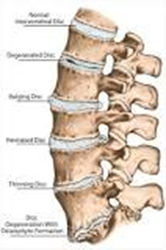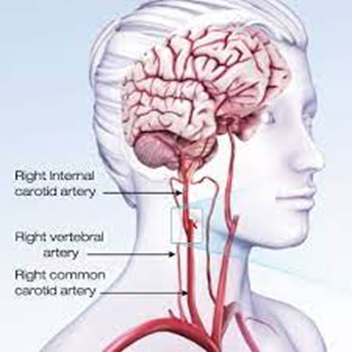A nurse is caring for a client who has degenerative disc disease. Which of the following assessment findings should the nurse understand might develop with this condition?
(Select All that Apply.)
Hyponatremia
Paresthesia
Foot drop
Intermittent pain Hyperreflexia
Correct Answer : B,C,D
Choice A Reason:
Hyponatremia is incorrect. Hyponatremia refers to low sodium levels in the blood and is not typically associated with degenerative disc disease. This finding is unrelated to the pathophysiology of DDD.
Choice B Reason:
Paresthesia is correct. Yes, paresthesia, which refers to abnormal sensations such as tingling, numbness, or burning, can develop with degenerative disc disease. Nerve compression or irritation due to disc degeneration can lead to paresthesia in the affected area, typically radiating along the nerve pathway.
Choice B Reason:
Foot drop is correct. Yes, foot drop can develop with degenerative disc disease, especially if the condition leads to nerve compression or damage in the lumbar spine (lower back). Foot drop refers to difficulty lifting the front part of the foot due to weakness or paralysis of the muscles involved in dorsiflexion.
Choice D Reason:
Intermittent pain is correct. Yes, intermittent pain is a hallmark symptom of degenerative disc disease. Pain may vary in intensity and may worsen with certain movements or activities. Individuals with DDD may experience episodes of acute pain, as well as chronic, persistent discomfort.

Nursing Test Bank
Naxlex Comprehensive Predictor Exams
Related Questions
Correct Answer is C
Explanation
Choice A Reason:
Prothrombin time (PT) is a laboratory test that measures the time it takes for blood to clot is incorrect. While PT may be part of a comprehensive evaluation in some cases, it is not typically the initial diagnostic test performed for a TIA. A TIA is caused by a temporary disruption of blood flow to the brain, often due to an embolus or transient blockage in a cerebral artery, rather than a primary disorder of blood clotting.
Choice B Reason:
Complete blood count (CBC) is incorrect. A complete blood count (CBC) is a common laboratory test that evaluates the cellular components of the blood, including red blood cells, white blood cells, and platelets. While CBC can provide valuable information about hematological conditions such as anemia or thrombocytosis, it is not specific to diagnosing the cause of a TIA. TIA is primarily a vascular event related to transient ischemia in the brain rather than a disorder of blood cell counts.
Choice C Reason:
Computerized tomography angiography (CTA) is appropriate. CTA is a non-invasive imaging test that combines computed tomography (CT) scanning with contrast dye to visualize blood vessels throughout the body, including those in the brain. CTA can help identify any blockages, narrowing, or abnormalities in the blood vessels supplying the brain, which may be contributing to the TIA. It provides detailed images of the blood vessels' structure and can help guide further management and treatment decisions.
Choice D Reason:
Transesophageal echocardiogram (TEE) is inappropriate. Transesophageal echocardiogram (TEE) is an imaging test that provides detailed images of the heart and major blood vessels using sound waves. While TEE may be indicated in some cases of TIA to evaluate for potential cardiac sources of emboli (blood clots), such as atrial fibrillation or cardiac valve abnormalities, it is not typically the first-line diagnostic test performed in the emergency department setting for evaluating a TIA. Initial imaging studies such as CTA or magnetic resonance imaging (MRI) of the brain are usually prioritized to assess for acute changes in cerebral blood flow and potential causes of the TIA.

Correct Answer is ["B","C","D","E"]
Explanation
Choice A Reason:
Pleural cavity decompression via needle aspiration is inappropriate. Pleural cavity decompression via needle aspiration may be indicated in cases of tension pneumothorax, a potentially life-threatening condition in which air accumulates in the pleural space and compresses the lung. While it is an intervention rather than a diagnostic tool, it may be performed emergently if tension pneumothorax is suspected based on clinical findings.
Choice B Reason:
Focused assessment with sonography in trauma (FAST) is appropriate. FAST is a bedside ultrasound examination commonly used in trauma settings to rapidly assess for the presence of free fluid in the pericardial, pleural, and peritoneal spaces. It can help identify hemopericardium, hemothorax, or intra-abdominal hemorrhage, which may be indicative of thoracic injury.
Choice C Reason:
Chest x-ray is appropriate. Chest x-ray is a commonly used imaging modality for evaluating thoracic injuries. It can help visualize abnormalities such as rib fractures, pneumothorax, hemothorax, pulmonary contusions, or other traumatic injuries to the chest.
Choice D Reason:
Thoracentesis is appropriate. Thoracentesis is a procedure used to sample fluid from the pleural space for diagnostic or therapeutic purposes. It may be indicated if there is a suspicion of pleural effusion or if fluid accumulation is seen on imaging studies such as chest x-ray or ultrasound.
Choice E Reason:
Ultrasound is appropriate. Ultrasound can be used to evaluate various aspects of thoracic injuries, including the presence of pneumothorax, hemothorax, or pleural effusion. It is often used as part of the FAST examination but can also be performed separately for more detailed assessment.
Whether you are a student looking to ace your exams or a practicing nurse seeking to enhance your expertise , our nursing education contents will empower you with the confidence and competence to make a difference in the lives of patients and become a respected leader in the healthcare field.
Visit Naxlex, invest in your future and unlock endless possibilities with our unparalleled nursing education contents today
Report Wrong Answer on the Current Question
Do you disagree with the answer? If yes, what is your expected answer? Explain.
Kindly be descriptive with the issue you are facing.
